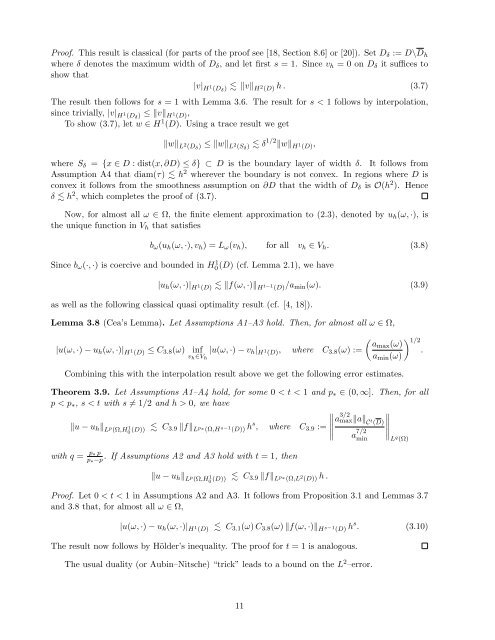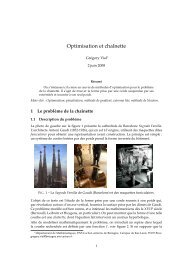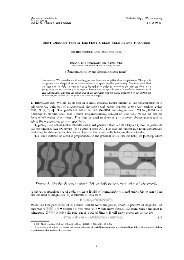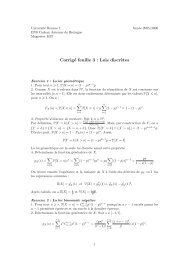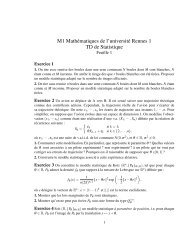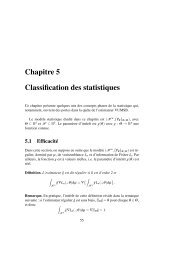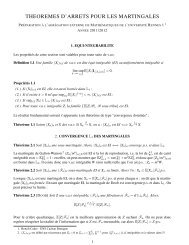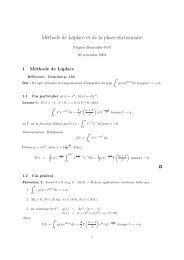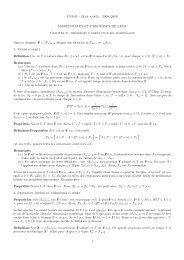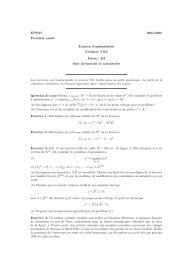Bath Institute For Complex Systems - ENS de Cachan - Antenne de ...
Bath Institute For Complex Systems - ENS de Cachan - Antenne de ...
Bath Institute For Complex Systems - ENS de Cachan - Antenne de ...
Create successful ePaper yourself
Turn your PDF publications into a flip-book with our unique Google optimized e-Paper software.
Proof. This result is classical (for parts of the proof see [18, Section 8.6] or [20]). Set D δ := D\D hwhere δ <strong>de</strong>notes the maximum width of D δ , and let first s = 1. Since v h = 0 on D δ it suffices toshow that|v| H 1 (D δ ) ‖v‖ H 2 (D) h . (3.7)The result then follows for s = 1 with Lemma 3.6. The result for s < 1 follows by interpolation,since trivially, |v| H 1 (D δ ) ≤ ‖v‖ H 1 (D),To show (3.7), let w ∈ H 1 (D). Using a trace result we get‖w‖ L 2 (D δ ) ≤ ‖w‖ L 2 (S δ ) δ 1/2 ‖w‖ H 1 (D),where S δ = {x ∈ D : dist(x, ∂D) ≤ δ} ⊂ D is the boundary layer of width δ. It follows fromAssumption A4 that diam(τ) h 2 wherever the boundary is not convex. In regions where D isconvex it follows from the smoothness assumption on ∂D that the width of D δ is O(h 2 ). Henceδ h 2 , which completes the proof of (3.7).Now, for almost all ω ∈ Ω, the finite element approximation to (2.3), <strong>de</strong>noted by u h (ω, ·), isthe unique function in V h that satisfiesb ω (u h (ω, ·), v h ) = L ω (v h ), for all v h ∈ V h . (3.8)Since b ω (·, ·) is coercive and boun<strong>de</strong>d in H0 1 (D) (cf. Lemma 2.1), we have|u h (ω, ·)| H 1 (D) ‖f(ω, ·)‖ H t−1 (D)/a min (ω). (3.9)as well as the following classical quasi optimality result (cf. [4, 18]).Lemma 3.8 (Cea’s Lemma). Let Assumptions A1–A3 hold. Then, for almost all ω ∈ Ω,|u(ω, ·) − u h (ω, ·)| H 1 (D) ≤ C 3.8 (ω)inf |u(ω, ·) − v h | Hv h ∈V 1 (D), where C 3.8 (ω) :=h( )amax (ω) 1/2.a min (ω)Combining this with the interpolation result above we get the following error estimates.Theorem 3.9. Let Assumptions A1–A4 hold, for some 0 < t < 1 and p ∗ ∈ (0, ∞]. Then, for allp < p ∗ , s < t with s ≠ 1/2 and h > 0, we have‖u − u h ‖ L p (Ω,H0 1(D)) C 3.9 ‖f‖ L p∗(Ω,H s−1 (D)) h s a 3/2max‖a‖ C, where C 3.9 :=t (D)∥ a 7/2 ∥minwith q = p∗ pp ∗−p. If Assumptions A2 and A3 hold with t = 1, then‖u − u h ‖ L p (Ω,H 1 0 (D)) C 3.9 ‖f‖ L p∗(Ω,L 2 (D)) h .∥L q (Ω)Proof. Let 0 < t < 1 in Assumptions A2 and A3. It follows from Proposition 3.1 and Lemmas 3.7and 3.8 that, for almost all ω ∈ Ω,|u(ω, ·) − u h (ω, ·)| H 1 (D) C 3.1 (ω) C 3.8 (ω) ‖f(ω, ·)‖ H s−1 (D) h s . (3.10)The result now follows by Höl<strong>de</strong>r’s inequality. The proof for t = 1 is analogous.The usual duality (or Aubin–Nitsche) “trick” leads to a bound on the L 2 –error.11


